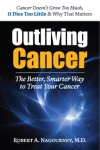Cancer Patients Need Answers Now!
February 26, 2015 Leave a comment
I read a sad editorial in the Los Angeles Times written by Laurie Becklund, former LA Times journalist. It is, in essence, a self-written obituary as the patient describes her saga beginning almost 19 years earlier, when she detected a lump in her breast. With stage I breast cancer she underwent standard therapy and remained well for 13 years until recurrence was heralded by disease in bone, liver, lung and brain. Given a dire prognosis she became a self-made expert, conducting research, attending conferences, and joining on-line forums under the name “Won’t Die of Ignorance.” Despite her heroic effort Ms. Becklund succumbed to her illness on February 8. She was 66.
Ms. Becklun d experienced the anguish that every patient feels when his or her own individual and highly personal needs simply aren’t being addressed. She opines that entities like the Susan G. Komen Fund, which has raised over $2.5 billion in the last 20 years, “channels only a fraction of those funds into research or assistance to help those who are already seriously sick.” She continues, “We need people, patients, doctors, scientists, politicians, industry and families to make a fresh start.” Her frustration is palpable as she states her outcome seemed to be based on the roll of the dice, like playing “Chutes and Ladders.”
d experienced the anguish that every patient feels when his or her own individual and highly personal needs simply aren’t being addressed. She opines that entities like the Susan G. Komen Fund, which has raised over $2.5 billion in the last 20 years, “channels only a fraction of those funds into research or assistance to help those who are already seriously sick.” She continues, “We need people, patients, doctors, scientists, politicians, industry and families to make a fresh start.” Her frustration is palpable as she states her outcome seemed to be based on the roll of the dice, like playing “Chutes and Ladders.”
The author’s plight is shared by the millions of patients who are confronting advanced cancers. They are not interested in “why” or “how” their cancers came to be. They can no longer benefit from early detection or cancer awareness campaigns. They need practical, actionable, clinical answers today.
Ms. Becklund’s commentary resonates with me and with everyone who has c ancer or knows someone who does. As an oncology fellow at Georgetown, I found myself losing patient after patient to toxic and largely ineffective treatments, all despite my best efforts. I described this in my book “Outliving Cancer.” It was then that I decided that I would dedicate myself to meeting the individual needs of each of my patients and I have used a laboratory platform (EVA-PCD) to do so. I have encountered surprising resistance from clinicians and researchers who seem to prefer the glacial pace of incremental advancement found in population studies over individual solutions found in the study of each patient’s unique biology. Ms. Becklund correctly points out that every treatment must meet each individual’s need.
ancer or knows someone who does. As an oncology fellow at Georgetown, I found myself losing patient after patient to toxic and largely ineffective treatments, all despite my best efforts. I described this in my book “Outliving Cancer.” It was then that I decided that I would dedicate myself to meeting the individual needs of each of my patients and I have used a laboratory platform (EVA-PCD) to do so. I have encountered surprising resistance from clinicians and researchers who seem to prefer the glacial pace of incremental advancement found in population studies over individual solutions found in the study of each patient’s unique biology. Ms. Becklund correctly points out that every treatment must meet each individual’s need.
The role of the scientist is to answer a question (treatment A vs. treatment B) while that of the clinical physician must be to save a life. Every patient is an experiment in real time. It may well be that no two cancer patients are the same. Indeed, the complexity of carcinogenesis makes it very possible that every patient’s cancer is an entirely new disease, never before encountered. Although cancers may look alike, they may be biologically quite distinct. Meaningful advances in cancer will only occur when we learn to apply all available technologies to treat patients as the individuals that they are. Let us hope that Ms. Becklund’ s final essay does not fall upon deaf ears.





